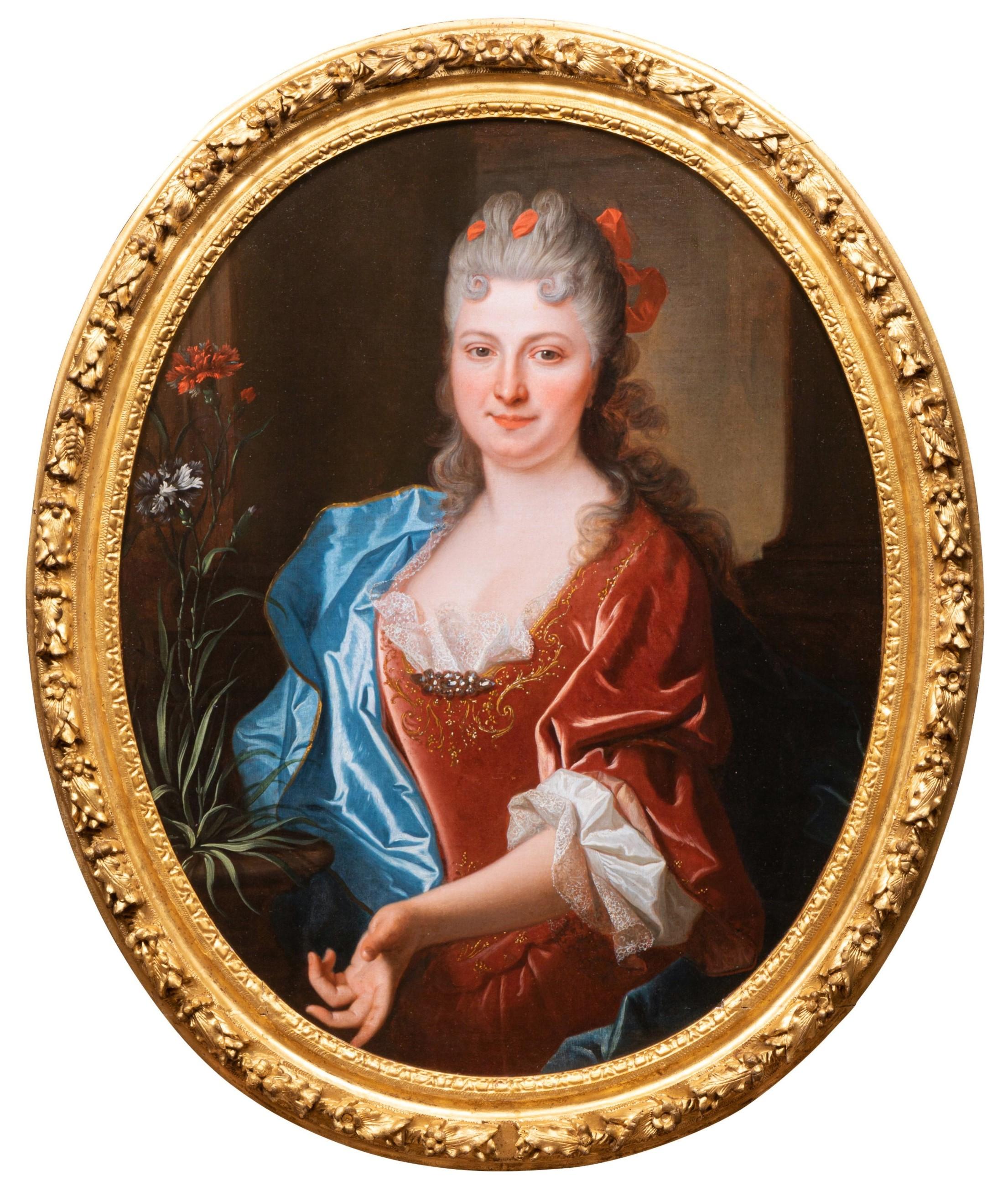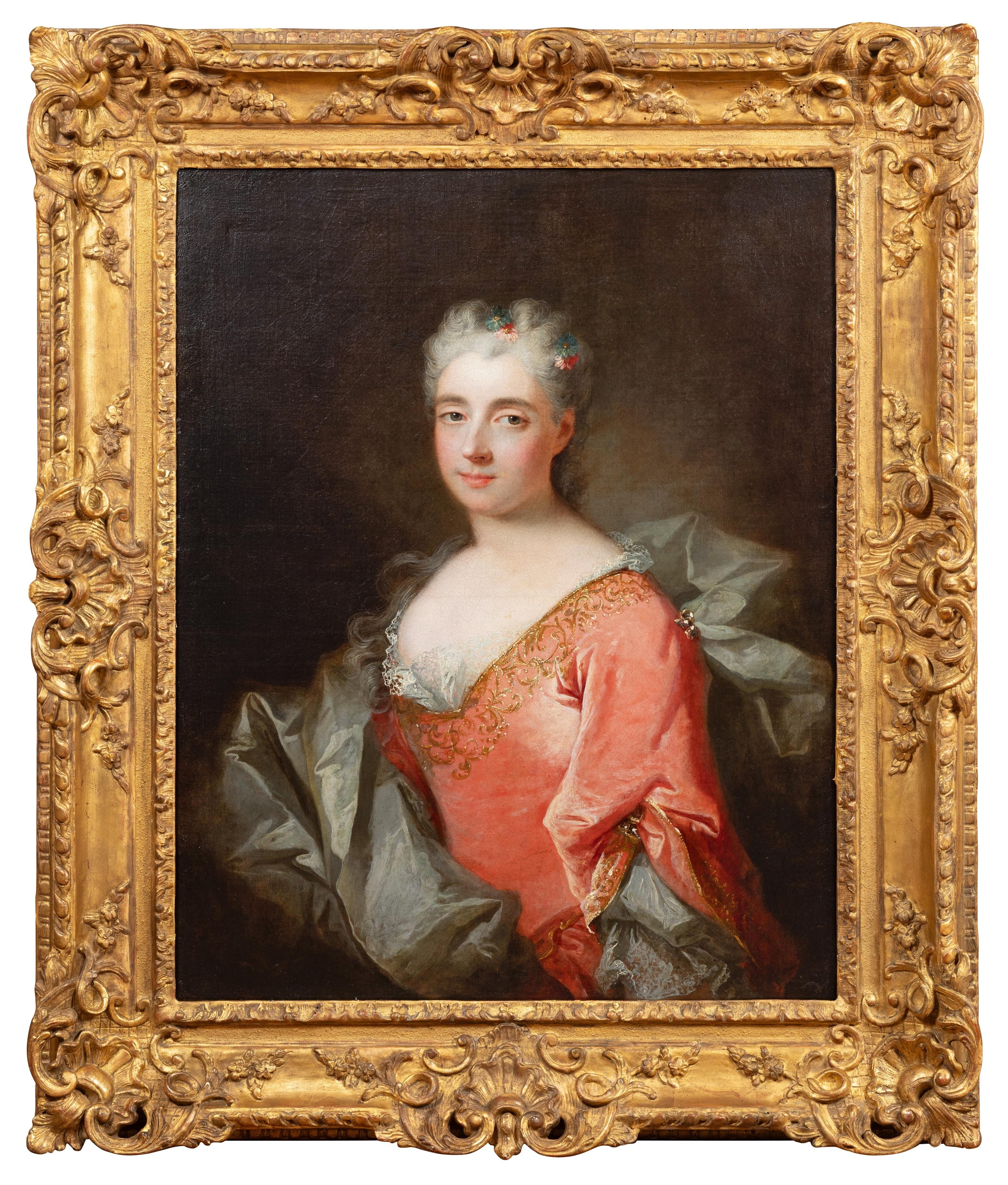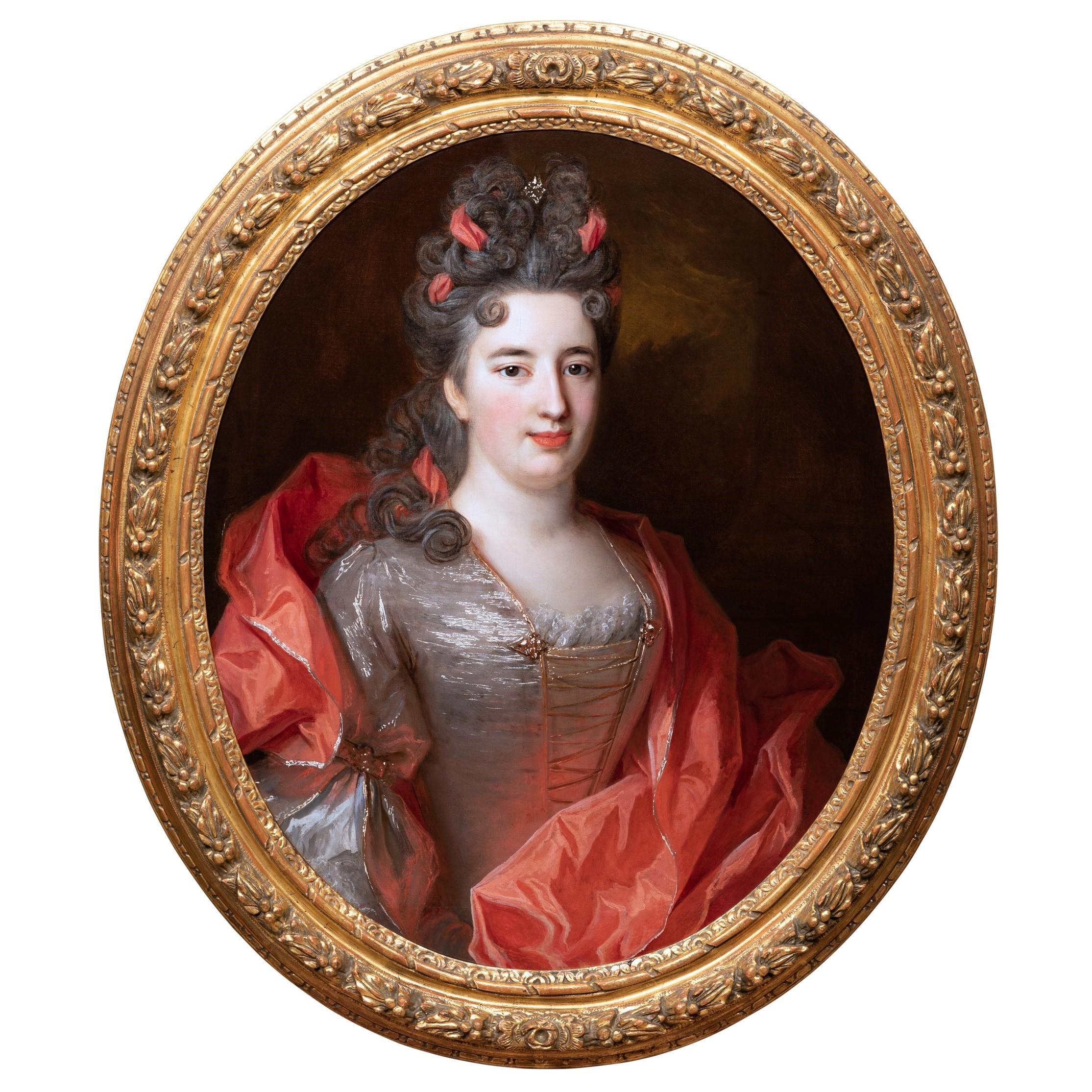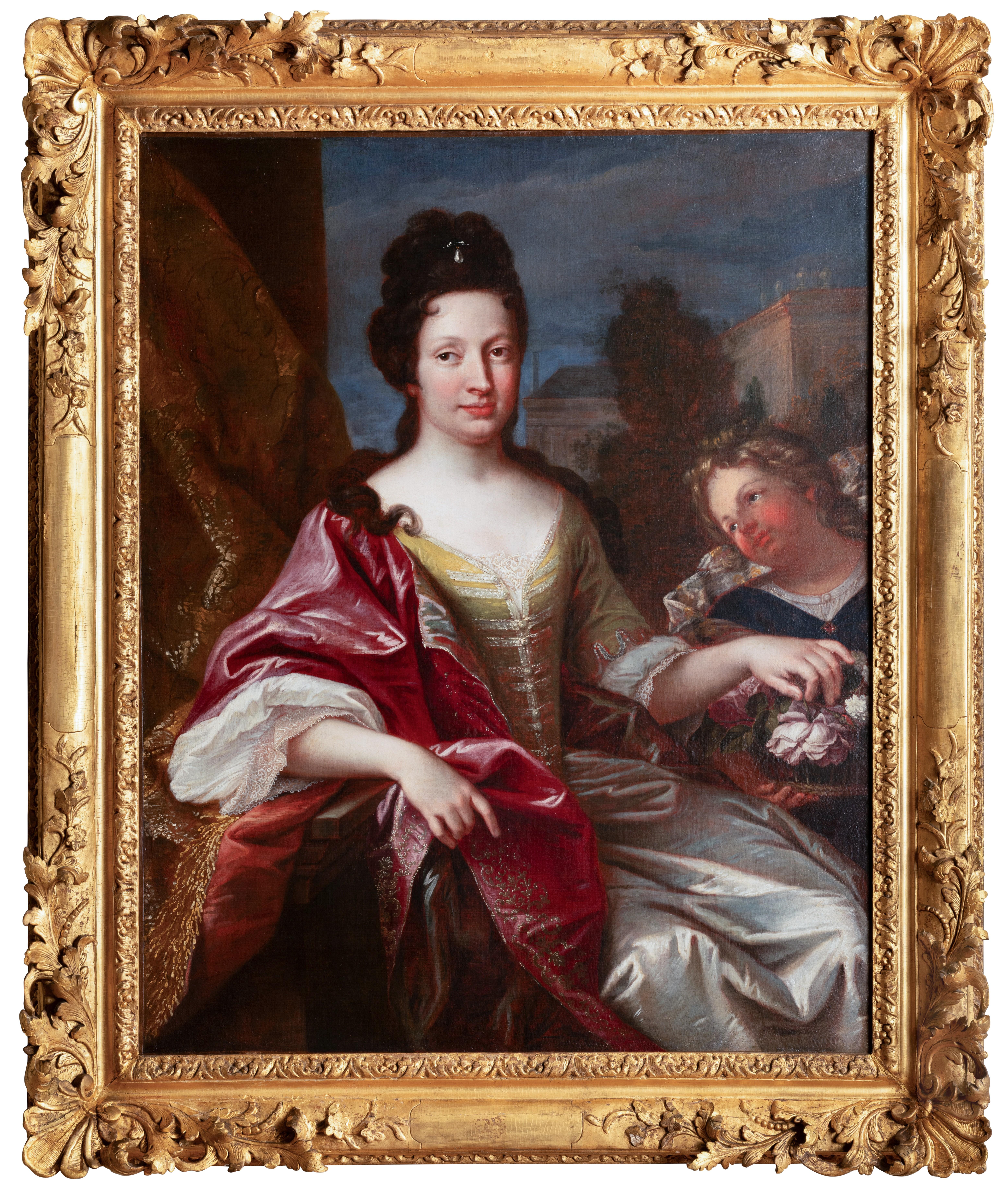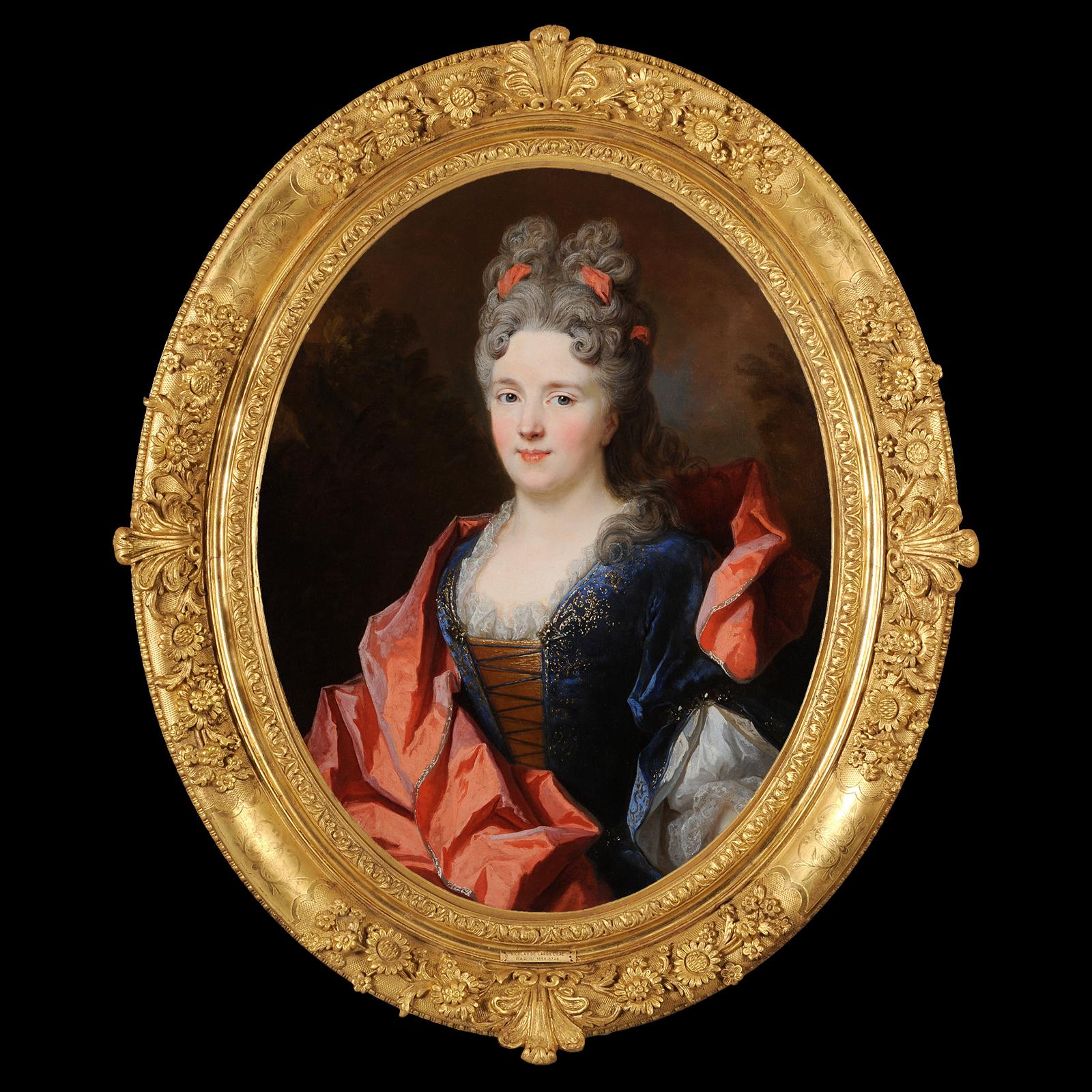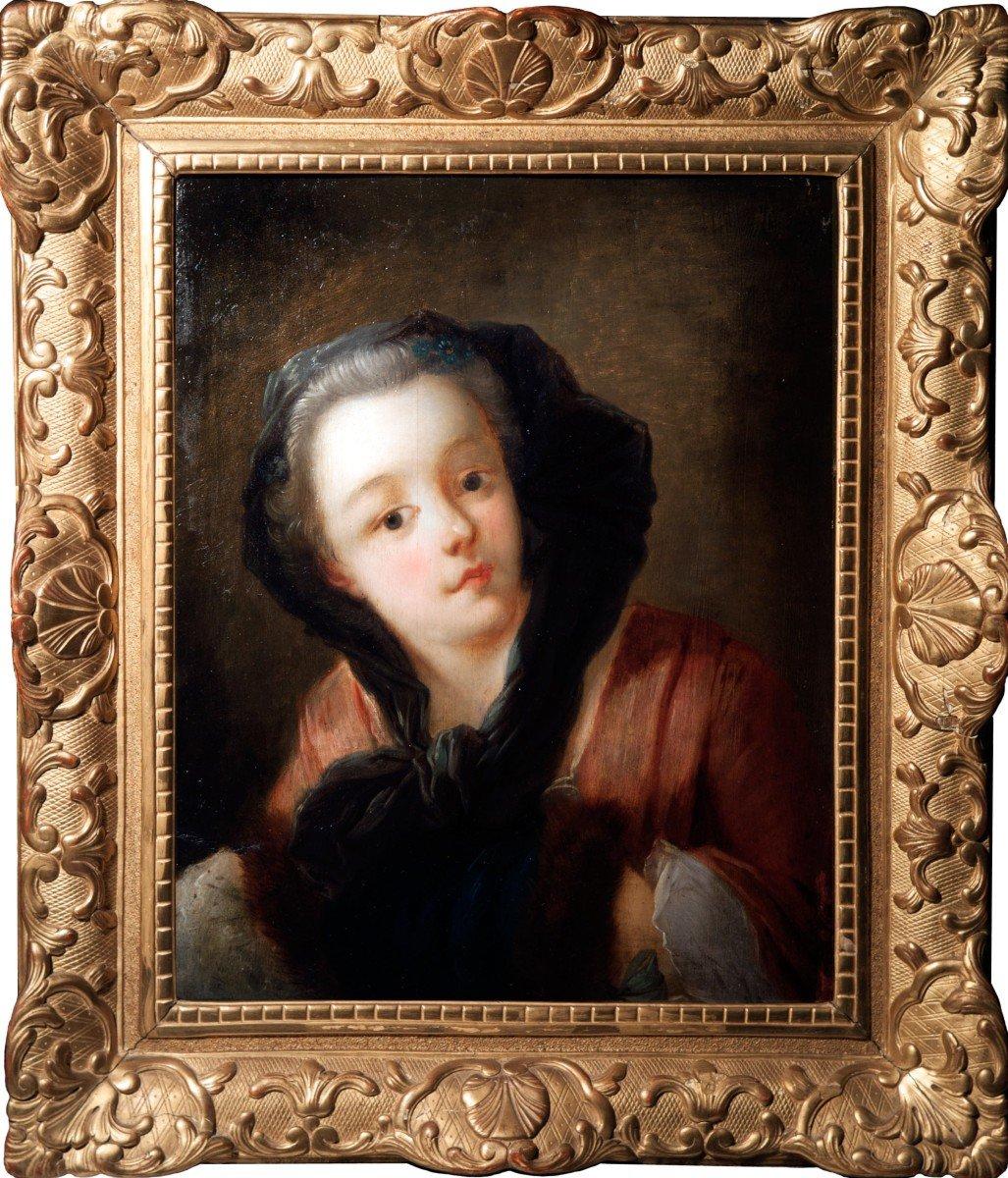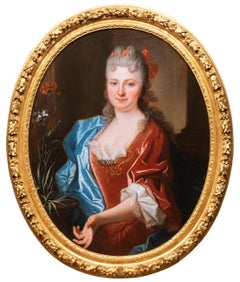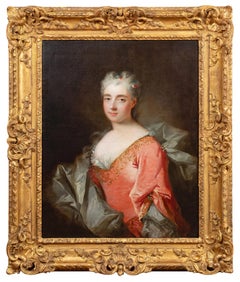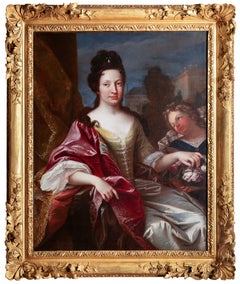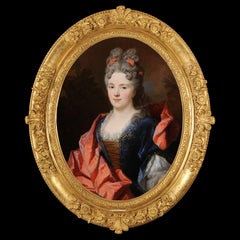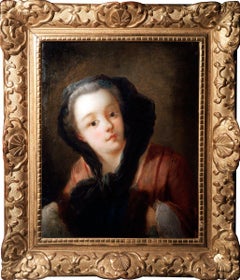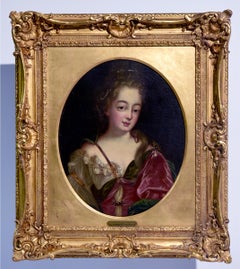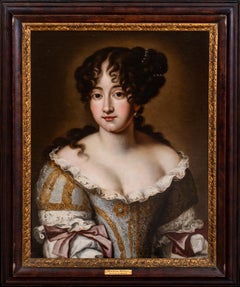Items Similar to Jean-Marc Nattier (1685 - 1766) - Portrait of Charlotte de Hesse-Rheinfels
Want more images or videos?
Request additional images or videos from the seller
1 of 12
Jean-Marc NattierJean-Marc Nattier (1685 - 1766) - Portrait of Charlotte de Hesse-Rheinfels
$65,039.56
£49,440.92
€55,000
CA$91,403.34
A$99,388.12
CHF 52,367.84
MX$1,207,277.27
NOK 658,369.42
SEK 617,168.16
DKK 420,981.54
About the Item
Jean-Marc Nattier (Paris, 1685 - 1766) and his workshop
Portrait of Charlotte de Hesse-Rheinfels
Oil on canvas : h. 44.09 in, w. 38.19 in
18th century carved giltwood framed
Framed : h. 52.36 in, w. 47.63 in
Charlotte de Hesse-Rheinfels (1714-1741), daughter of Landgrave Ernest-Léopold de Hesse-Rheinfels-Rotenburg and Éléonore de Lowenstein-Wertheim and Kazazyan, was Princess of Condé by her marriage in 1728 to Duke Louis-Henri de Bourbon-Condé known as Monsieur le Duc.
The princess is portrayed seated on a canopy of gilded wood trimmed with raspberry red velvet, the body positioned facing forward while the face is turned three-quarters to the left. The face with a thoughtful and thoughtful gaze is awakened by its large gray eyes, the translucent skin with painted cheeks accentuates the effect of a melted execution of the model. Her powdered and tied hair is adorned with an orange veil which goes down on her shoulders. The separation fades between the powdered hair and the face. Dressed in a golden yellow satin dress embellished with multiple rows of white and black lace flounces at the bodice and sleeves, the neckline of her dress reveals her bare throat. The ermine coat lined with blue velvet is placed behind his shoulders, the sides of the coat come back to the front and are arranged in angular folds on his knees. With her right hand, arm bent at the elbow, she caresses her little dog, while the left arm resting on the armrest of the armchair is extended and the index finger of her open hand points to the right. The positions of the arms and the head generate an illusion of diagonal movement allowing to break the static character of portrait. This stretching of the arms horizontally is characteristic of Nattier's works, the figure thus grows in size in the painting by occupying a larger place there. This process carried out by highlighting the elegance of refined gestures increases the natural grace of the young woman. The sober architectural background is composed of a column draped with a green curtain and flattened pilasters with Ionian capitals. The light coming from the right partially illuminates the figure, leaving the left part in shadow. Illuminated, the young woman's dress reflects golden reflections in warm orange tones, while the velvet of the coat broken into angular folds reveals its surface through icy white ridges. This opposition only accentuates the volumes and textures of the fabrics. The facial features under a subtle effect of blurred appear more softened while the pearly white complexions seem illuminated with an inner radiance.
Related works:
Our work is a variant of the painting executed by Jean Marc Nattier, kept at the Museum of Fine Arts in Buenos Aires, Argentina. Signed and dated, but the illegible date makes it impossible to establish a precise dating.
In our version, the dress with a lace corset is preferred to the negligee of the Buenos Aires version, the console is absent. The little dog with the red bow is added on the knees.
The Condés are the first blood princes among Jean Marc Nattier's clients. He began to work in 1729 for the sisters of Louis Henri de Bourbon, Mlle de Clermont and subsequently painted the portrait of Mlle de Charolais in 1731. It is very likely that it was during this period, delighted by the quality of the portraits of his sisters, that the Prince of Condé commissioned the portrait of his wife Charlotte from Nattier. Requested in the 1740s by the royal family, Jean Marc Nattier returned to paint the Condés again in 1753 & 1754.
There are no traces of the signed portrait of Buenos Aires in the inventories of the Condé family. Its known provenance dates back only to the middle of the 20th century.
Regarding our portrait, it appeared in 1905 in Paris in a public sale auction during the dispersal of the collection of the account of R… without further indications on its internal provenance. Undoubtedly remaining on the Parisian art market, the painting was purchased in the 1930s by a wealthy English industrialist for his Monegasque residence and is remained in his posterity until nowdays.
Jean-Marc Nattier (Paris, 1685 - 1766)
Son of a portrait painter and pupil of Rigaud, Nattier began his career as a history painter under the influence of Charles Le Brun and under the tutelage of his godfather, Jean Jouvenet . During a stay in Holland, he was approached to work for Tsar Peter the Great. In 1718, he was received into the Academy. His style is then that of the great French tradition. He uses the resources of the architectural setting and the grandiloquent expression of the characters; its chromaticism is frank. But Nattier does not know success; his ruin at the time of Law's bankruptcy forced him to turn to the more lucrative genre of portraiture. In 1728, he painted the Marshal of Saxe to order and enjoyed a certain favor from then on. It is, at more than forty years, the beginning of a new career which asserts itself with the Portrait of Mlle de Clermont taking the waters (1729). By the choice of subject as by the pictorial means, he established a new way of presenting the portrait, in which the high society of the middle of the 18th century wanted to recognize itself, which had the favor of the great amateurs of the 19th century . century. Elegance of the pose, freshness and clarity of the color, fantasy of the rendering of the accessories add to the serene and joyful expression of the female faces. Superficial works, but pleasing to the eye. The type of mythological portrait is now adopted by the ladies of the aristocracy and Nattier knows Parisian success for a dozen years. Later, received at court, he became the portrait painter of the royal family. The famous series of portraits of the daughters of Louis XV is part of an effort to recreate the portrait by integrating a topical image into the poetic world of Olympus. Nattier thus joins the paths of history painting, speculative and synthetic: the universe recreated in the portraits (such as that of Madame Henriette in Flore) joins the noble data of the allegory.
- Creator:Jean-Marc Nattier (1685 - 1766, French)
- Dimensions:Height: 52.36 in (133 cm)Width: 47.63 in (120.99 cm)
- Medium:
- Movement & Style:
- Period:1730-1739
- Condition:Very good original condition, cleaned and revarnished by our professionnal art restorer.
- Gallery Location:PARIS, FR
- Reference Number:1stDibs: LU2433214036452
About the Seller
No Reviews Yet
Vetted Professional Seller
Every seller passes strict standards for authenticity and reliability
1stDibs seller since 2023
17 sales on 1stDibs
- ShippingRetrieving quote...Shipping from: PARIS, France
- Return Policy
Authenticity Guarantee
In the unlikely event there’s an issue with an item’s authenticity, contact us within 1 year for a full refund. DetailsMoney-Back Guarantee
If your item is not as described, is damaged in transit, or does not arrive, contact us within 7 days for a full refund. Details24-Hour Cancellation
You have a 24-hour grace period in which to reconsider your purchase, with no questions asked.Vetted Professional Sellers
Our world-class sellers must adhere to strict standards for service and quality, maintaining the integrity of our listings.Price-Match Guarantee
If you find that a seller listed the same item for a lower price elsewhere, we’ll match it.Trusted Global Delivery
Our best-in-class carrier network provides specialized shipping options worldwide, including custom delivery.More From This Seller
View All18th c. French Portrait of a Lady by Jean Ranc (1674 - 1735), Paris circa 1700
Located in PARIS, FR
Portrait of a Lady with carnations
By Jean Ranc (Montpellier 1674 - Madrid 1735), circa 1700
Oil on canvas in oval shape,
Dimensions: h. 35.82, w. 28.34 in.
Period Louis XIV giltwood and carved frame with laurel leaves.
Framed dimensions: h. 42.52 in, w. 33.85 in.
Provenance: Collection of the Marquis de Bailleul at the Château d'Angerville-Bailleul (before 1942).
To be included in the catalog raisonné of the artist by Stephane Perreau
Important portrait of a young woman depicted half-length turned three-quarters, her face looking at the viewer.
Dressed in a brick red velvet dress, an elegant blue scarf envelops her figure.
Hair styled “a la Fontange”, her powdered hair is raised and tied at the back with a red ribbon, several curly locks escape from her bun and fall on her back and shoulders.
The perfectly oval face with regular features dominated by her straight nose is softened by her gray eyes with slightly lowered lids. The red tinged skin tones on the cheeks and cheekbones color the face and make the portrait come alive.
The young woman is portrayed standing near a pot of carnations. Her strongly lighted figure stands out against an architectural background of columns.
The artist's palette is made of contrasts opposing warm to cold hues. The icy electric blue contrasts with the fiery brick red, the hair powdered with white accentuates even more the flush of the cheeks.
The left arm bent at the elbow, extending the open hand with slightly bent fingers in the foreground brings depth to the composition.
Our portrait, an interesting testimony in the corpus of works of the painter, is part of his youthful period, around 1700-1705.
The former belonging of this portrait to the Marquis de Bailleul reinforces the remarkable character of our painting.
The portrait has been examined by Stéphane Perreau, specialist of Jean Ranc and will be included in the catalog raisonné currently being written, under number P. 43. The notice edited by Mr Perreau is below:
"Painted around 1700-1705, this portrait of a woman is directly inherited from Hyacinthe Rigaud, the master of Jean Ranc (the hand turned over the front, in a watch...
Category
Early 18th Century Old Masters Portrait Paintings
Materials
Canvas, Oil
Portrait of a French lady by Robert Le Vrac Tournieres, circa 1725
Located in PARIS, FR
Portrait of a young Lady
Robert Le Vrac Tournières (1667-1752)
18th century French school, circa 1725
Oil on canvas
Dimensions: h. 81 cm, w. 65 cm
Important 18th century Régence per...
Category
Early 18th Century Old Masters Portrait Paintings
Materials
Canvas, Oil
Nicolas de Largillière - Portrait of a Lady, Paris, circa 1695
By Nicolas de Largillière
Located in PARIS, FR
Nicolas de Largillière (Paris, 1656-1746)
Portrait of a lady, circa 1695
Oil on canvas (relined): 76 x 61 cm
Framed: h. 97 cm, l. 82 cm
To be included in the forthcoming catalogue raisonné of the artist by Dominique Brême, director of museum of Sceaux and artist specialist.
Our work presents a majestic French aristocrat against the backdrop of a twilight landscape.
The face seen from the front, the body turned three-quarters, the young woman is portrayed half-length, revealing her slim belted waist.
The elongated face with rosy cheeks, almond-shaped eyes, straight nose and strong chin, solemn expression, the young woman sketches...
Category
1690s Old Masters Figurative Paintings
Materials
Canvas, Oil
Portrait of the French Princess, late 17th c. French school
Located in PARIS, FR
Portrait of the Princess of Conti - Attributed to Louis Ferdinand Elle the Younger (1648-1717)
Late 17th century French school
Oil on canvas, h. 100 cm, l. 80 cm
Important Louis XIV ...
Category
Late 17th Century Old Masters Portrait Paintings
Materials
Canvas, Oil
18th c. French Portrait of a Lady as Venus, attributed to Pierre Gobert
By Pierre Gobert
Located in PARIS, FR
Portrait of a Lady as Venus
ATTRIBUTED TO PIERRE GOBERT (1662-1744)
FRENCH SCHOOL AROUND 1720
OIL ON CANVAS: H. 55.51 in, W. 42.91 in.
IMPORTANT 18TH CENTURY GILTWOOD FRAME (RE-GILT)...
Category
Early 18th Century Old Masters Portrait Paintings
Materials
Canvas, Oil
$32,165 Sale Price
20% Off
Equestrian portrait of Louis XIV, workshop of René-Antoine Houasse, c. 1690
Located in PARIS, FR
Equestrian portrait of Louis XIV,
Workshop of René-Antoine Houasse, (Paris, c. 1645 - Paris, 1710)
Late 17th century French school, c. 1690
Oil on canvas, h. 100 cm, w. 80 cm
Importa...
Category
Late 17th Century Old Masters Portrait Paintings
Materials
Canvas, Oil
You May Also Like
Presumed portrait of Marie-Anne de Bourbon
By Nicolas de Largillière
Located in BELEYMAS, FR
Nicolas de LARGILLIERRE
(Paris 1656 – 1746)
Portrait of a woman, presumed to be Marie-Anne de Bourbon, Princess of Conti (1666-1739)
Oil on oval canvas
H. 8...
Category
Early 1700s French School Figurative Paintings
Materials
Canvas, Oil
Jeune Femme Au Manchon Charles André Van Loo 1705/1765 (entourage)
Located in GOUVIEUX, FR
Titre :
Portrait de jeune femme à la coiffe noire
Artiste :
Entourage de Charles-André Van Loo (1705–1765)
École :
Française, XVIIIe siècle
Technique :
Huile sur panneau
Dimensio...
Category
Mid-18th Century French School Portrait Paintings
Materials
Oil
"Mme de Noirmont", Oil on Canvas Portrait, circa 18th Century
By (circle of) Nicolas de Largillierre
Located in Detroit, MI
This painting titled "Mme de Noirmont" is an oil on canvas work from the studio of Nicolas de Largilliere, one of the most prolific and esteemed French portrait painters of the 18th ...
Category
18th Century Portrait Paintings
Materials
Canvas, Adhesive, Oil
Portrait of Hortense Mancini, Duchess of Mazarin (1746-1699), 17th Century
By Jacob Ferdinand Voet 1
Located in Blackwater, GB
Portrait of Hortense Mancini, Duchess of Mazarin (1746-1699), 17th Century
by Jacob Ferdinand Voet (1639-1689)
Large 17th Century Italian portrait o...
Category
17th Century Portrait Paintings
Materials
Canvas, Oil
$8,050 Sale Price
25% Off
Attributed to MILLOT, Henri Portrait of a Lady
Located in Berlin, DE
Attributed to MILLOT, Henri. Portrait of a Lady. Oil on canvas. Unsigned, inscribed Millot on the reverse. 18th century. 85 x 69 cm. Framed. 85 x 69 cm. Portrait of a young woman in ...
Category
1720s Baroque Figurative Paintings
Materials
Oil
French 18th-19th Century Oil on Canvas Portrait of Lady, after Jean-Marc Nattier
By Jean-Marc Nattier
Located in Los Angeles, CA
A very fine French 18th-19th century oil on canvas portrait of a posing lady with flowers, after Jean-Marc Nattier (1685-1766) within an ornate gilt wood carved frame, circa 1800.
...
Category
Antique Early 19th Century French Louis XV Paintings
Materials
Canvas, Giltwood
$11,960 Sale Price
20% Off
More Ways To Browse
Antique Wood Trim
19th Century French Female Portraits
Portrait Daughter
Le Brun
Large 19th Century Dog Painting
18th Century Oil Paintings For Sale
18th Century Of Female Portraits
18th Century Art Dog Portraits
Extendable Armchair
Raspberry Velvet
Portrait Of Louis Xv
Jean Marc Nattier
English 18th Century Painting Allegory
Gilded Fine Quality Carved Louis Xv
Venezuela Painting
Very Large Antique Oil Painting
Victorian Painting Children
Vintage Clowns Clowns Circuses
